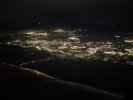- Joined
- May 24, 2016
- Messages
- 961
- Display Name
Display name:
4RNB
My spouse is away so I figured it would be a good time to go do my 3 night takeoff and landings. I familiarized myself with the rules with regards to the proper times, thought to go up a bit early during civil twilight, get used to the night sky again. I have not flown at night in maybe two years and really only have near minimum amount of time. Winds calm on the ground. My plan was to fly for about 30 minutes, then maybe land at a nearby airport, head back home and do the rest of the landings and takeoffs. Halfway to the destination the plane was buffeted in light turbulence, my pilot window blew open. I put AP on, fixed the window, turned back for home thinking that maybe the air was more unsettling as I reached water (a river that was opening up). Destination airport wind was @9.
So I proceeded to just do a 5 mi circle 2500 ft above home airport, had periodic unevenness. As this continued I reappraised my plans for the night, made note of little illumination from the moon, and figured maybe just getting safe on the ground was enough. At 2500 ft, most I saw the wind was 15, on base to final this was 24, short final 16. My alignment was crap because of the wind but brought things in well enough, wind decreased to 6 maybe 200 ft above the ground. Ground crew said it had been like this for a few days, get 300 feet up and the wind situation really became a factor. It was fun to push the envelope a bit, do something I had not done for a while.
THe radios were near silent for duration of flight on a very popular CTAF frequency.
My preflight wx check was only to look at local TAF. I need to rethink and better come up with a mental checklist for night flight, here seeking your input, what do you do?
1- Do a better wx check, winds aloft are key. Maybe re read wx books and see if there are patterns to expect. I expected clear calm.
2- Add the moonlight in as a safety factor
3- Better understand lighting relationship in the cockpit. Cabin light off had PFD about right but GPS too dim. When cabin light sufficient to see breakers, knobs, switches (carb heat/TOGO etc) the displays became too bright. I wonder if I could get a small amount of red light down lower on the panel.
4- Check window latch?
5- What else?
So I proceeded to just do a 5 mi circle 2500 ft above home airport, had periodic unevenness. As this continued I reappraised my plans for the night, made note of little illumination from the moon, and figured maybe just getting safe on the ground was enough. At 2500 ft, most I saw the wind was 15, on base to final this was 24, short final 16. My alignment was crap because of the wind but brought things in well enough, wind decreased to 6 maybe 200 ft above the ground. Ground crew said it had been like this for a few days, get 300 feet up and the wind situation really became a factor. It was fun to push the envelope a bit, do something I had not done for a while.
THe radios were near silent for duration of flight on a very popular CTAF frequency.
My preflight wx check was only to look at local TAF. I need to rethink and better come up with a mental checklist for night flight, here seeking your input, what do you do?
1- Do a better wx check, winds aloft are key. Maybe re read wx books and see if there are patterns to expect. I expected clear calm.
2- Add the moonlight in as a safety factor
3- Better understand lighting relationship in the cockpit. Cabin light off had PFD about right but GPS too dim. When cabin light sufficient to see breakers, knobs, switches (carb heat/TOGO etc) the displays became too bright. I wonder if I could get a small amount of red light down lower on the panel.
4- Check window latch?
5- What else?


